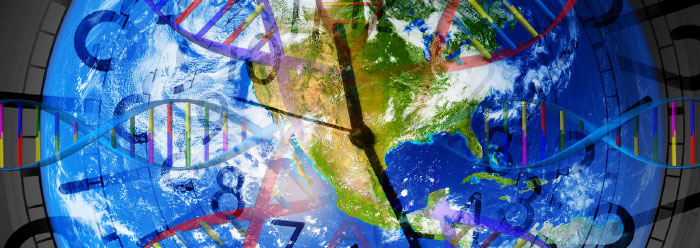The idea of an evolutionary genetic clock in which DNA sequences steadily change, like a clock ticking off time, has played a major role in the ideas shaping modern biology. As employed by evolutionists, this time-measuring technique compares DNA sequences between different species to estimate supposed rates of evolution based on the amount of changes in individual DNA letters (A, T, C, or G) in the DNA. When two totally different types of creatures are compared (e.g., horses and chickens), their differences are made to match up with evolutionary time through a procedure that calibrates the data with deep-time estimates taken from paleontology.1 While scientists that work in the field know this, the general public is completely unaware of this little trick.
Despite the fact that the genetic clock data are clearly manipulated to conform to vast amounts of evolutionary time, the results rarely support the overall evolutionary story. In fact, the following problems are often encountered.
- Different genes give widely different evolutionary rates.
- Different types of organisms exhibit different rates for the same type of gene sequences.
- Genetic-clock dates that describe when these creatures supposedly split off to form new creatures (called divergence) commonly disagree with paleontology’s timescale despite being calibrated by it.1
What kind of data would researchers get if the assumptions of evolution and deep time were not used to bias the molecular-clock models? Would the DNA sequence variation actually provide usable information to help test creationist predictions about origins? Interestingly, we have a variety of reported studies from both secular scientists and creationist researchers in which DNA clocks were measured empirically—without deep-time calibrations—and yielded ages of only 5,000 to 10,000 years, not millions. Each of these test cases are discussed below, but first let’s visit the closely related concept of genetic entropy.
Genomic Entropy and Genetic Clocks
During the production of egg and sperm, DNA mutations can occur and be passed on to the next generation. When these are empirically measured within a family’s pedigree, an estimate of the mutation rate can be achieved. Scientists have actually measured this rate in humans in a number of studies and found it to be between 75 and 175 mutations per generation.2-6
Using this known data about mutation rates, a variety of researchers have used computer simulations to model the accumulation of mutations in the human genome over time.7-13 It was found that over 90% of harmful mutations fail to be removed over time and are passed on to subsequent generations. Because this buildup of mutations would eventually reach a critical level, it was postulated that humans would eventually go extinct at a point called error catastrophe.14,15 This incessant process of genome degradation over time with each successive generation is called genetic entropy.14,15 More amazing, the process of genetic entropy is closely mirrored by the trend of declining human life-span documented in the Bible, especially in the 4,300 years since the global Flood.12,15-17 In addition to these genetic simulation studies, prominent evolutionists have shown that the problem of mutation accumulation in the human genome is accompanied by the inability of natural selection to remove them—an aspect of genetics completely contrary to evolutionary assumptions.5,18
The conclusions of these studies in modeling genetic entropy have been spectacularly confirmed by two additional secular studies based on empirical data that provided the same results, along with a timescale that paralleled biblical history.4,5 Both studies examined the amount of rare single nucleotide differences in the protein-coding regions (exons) of the human genome called the exome.19,20 One study analyzed 2,440 individuals and the other 6,515. Over 80% of the rare variability was considered to be harmful (associated with heritable disease), and researchers attributed the presence of these mutations to “weak purifying selection.”19 This essentially means that the alleged ability of natural selection to remove these harmful variants from human populations was somehow powerless to do so—the exact same results observed in the computer simulation studies discussed above.8,11-13
A major benefit of this type of genetic data is the fact that protein-coding regions are less tolerant of mutation than other parts of the genome, providing more reliable historical genetic information about human populations than more common types of variability. In addition, this type of data can be conveniently integrated into demographic models over known historical time and geographical space. When the researchers did this, they discovered a very recent and massive burst of human genetic diversification primarily associated with genetic entropy. One of the research papers stated, “The maximum likelihood time for accelerated growth was 5,115 years ago.”19 The other paper uncovered a similar timeline, which places the beginning of human genetic diversification close to the Genesis Flood and subsequent dispersion of people groups at the Tower of Babel. Importantly, this recent explosion of rare genetic variants clearly associated with genetic entropy also follows the same pattern of human life expectancy rapidly declining after the Flood.15,17
Mitochondrial DNA Variability and Genetic Clocks
One other important realm of molecular-clock research demonstrating a recent creation comes from examining mutation rates in mitochondrial genomes.21 The mitochondrial DNA (mtDNA) of an animal is typically inherited from the mother’s egg cell, and the mtDNA mutation rates can accurately be measured in pedigrees to produce a specific clock for that species. When these clocks are calibrated not by evolutionary timescales but by using the organism’s known generation time, a more realistic and unbiased estimate of that creature’s genetic clock can be obtained. By comparing these mitochondrial clocks in fruit flies, roundworms, water fleas, and humans, one creation scientist demonstrated that a creation event for all of these organisms (including humans) occurred not more than 10,000 years ago.21
Other creation scientists also conducted a study into human mtDNA variation in which they statistically analyzed over 800 different sequences and reconstructed a close approximation of Eve’s original mitochondrial genome.15,22 They found that “the average human being is only about 22 mutations removed from the Eve sequence, although some individuals are as much as 100 mutations removed from Eve.”15 The most recent empirical estimate of the mutation rate in human mitochondria is about 0.5 per generation.23 Based on this rate, even for the most mutated mitochondrial sequences, it has been determined that “it would only require 200 generations (less than 6,000 years) to accumulate 100 mutations.”15
Lest critics say that these mtDNA studies are suspect because they were performed by creationists, it should be noted that evolutionists were actually the first to document these biblically supportive timeframes. Buried within a secular research paper back in 1997, the same trends recently observed by creationists regarding human mtDNA mutation rates were first reported but received little attention in the evolutionary community. The authors of the paper stated, “Using our empirical rate to calibrate the mtDNA molecular clock would result in an age of the mtDNA MRCA [most recent common ancestor, or the first human woman] of only ~6,500 years.”24
One year later, another secular researcher remarked on this study, stating,
Regardless of the cause, evolutionists are most concerned about the effect of a faster mutation rate. For example, researchers have calculated that “mitochondrial Eve”—the woman whose mtDNA was ancestral to that in all living people—lived 100,000 to 200,000 years ago in Africa. Using the new clock, she would be a mere 6000 years old.25
The article continued to note that the new findings of faster mutation rates pointing to mitochondrial Eve about 6,000 years ago also contributed to the development of mtDNA research guidelines used in forensic investigations adopted by the FBI. Now, over 17 years later, and using even more mtDNA data, creation scientists are spectacularly confirming this previous unheralded discovery.
In addition to the mtDNA clock data, scientists have also analyzed the Y chromosomes of modern men, which they found to be only about 300 mutations on average different from the consensus sequence of a Y-chromosome Adam.15 The researchers state that “even if we assume a normal mutation rate for the Y chromosome (about 1 mutation per chromosome per generation), we would only need 300 generations (about six thousand years), to get 300 mutations.”15 As with the previous mtDNA work, this is the most straightforward way to apply the DNA clock concept, which also provides data in perfect agreement with a biblical timeframe for the origins of man.
Perhaps the most remarkable data supporting a young creation were recently published by a large group of secular scientists who are involved with mapping DNA variation across the entire human genome.26 This massive effort has just produced a huge dataset that the researchers call “a global reference for human genetic variation.” In their report, they state:
Analysis of shared haplotype lengths around f2 variants suggests a median common ancestor ~296 generations ago (7,410 to 8,892 years ago), although those confined within a population tend to be younger, with a shared common ancestor ~143 generations ago (3,570 to 4,284 years ago).26
Amazingly, these are fairly accurate dates for both the original creation event and the Babel dispersion after the Flood. The confined populations are descended from the people groups created at the Tower of Babel when the languages became confused. Of course, the median common ancestor of all humans would represent Adam and Eve.
Conclusion
The evolutionary paradigm of a molecular clock is deeply flawed in that it assumes evolution on a grand scale and literally involves conducting the whole analysis as a hypothetical exercise rather than as an empirical experiment. In contrast, creation scientists and even some secular researchers have taken a straightforward empirical approach without any assumptions about time, and the results yield dates of not more than about 6,000 to 10,000 years. Thus, when the mythical evolutionary restrictions are removed and the data are analyzed empirically, biblical timescales are the result.
References
- Tomkins, J. P. and J. Bergman. 2015. Evolutionary molecular genetic clocks—a perpetual exercise in futility and failure. Journal of Creation. 29 (2): 26-35. Much of the content of this current article was published previously at a more technical level. See Tomkins, J. P. 2015. Empirical genetic clocks give biblical timelines. Journal of Creation. 29 (2): 3-5.
- Nachman, M. W. and S. L. Crowell. 2000. Estimate of the mutation rate per nucleotide in humans. Genetics. 156 (1): 297-304.
- Kondrashov, A. S. 2003. Direct estimates of human per nucleotide mutation rates at 20 loci causing Mendelian diseases. Human Mutation. 21 (1): 12-27.
- Xue, Y. et al. 2009. Human Y Chromosome Base-Substitution Mutation Rate Measured by Direct Sequencing in a Deep-Rooting Pedigree. Current Biology. 19 (17): 1453-1457.
- Lynch, M. 2010. Rate, molecular spectrum, and consequences of human mutation. Proceedings of the National Academy Science. 107 (3): 961-968.
- Campbell, C. D. and E. E. Eichler. 2013. Properties and rates of germline mutations in humans. Trends in Genetics. 29 (10): 575-584.
- Sanford, J. et al. 2007. Mendel’s Accountant: A biologically realistic forward-time population genetics program. Scalable Computing: Practice and Experience. 8 (2): 147-165.
- Sanford, J. et al. 2007. Using Computer Simulation to Understand Mutation Accumulation Dynamics and Genetic Load. Lecture Notes in Computer Science. 4488: 386-392.
- Sanford, J. C. and C. W. Nelson. 2012. The Next Step in Understanding Population Dynamics: Comprehensive Numerical Simulation. Studies in Population Genetics. M. C. Fusté, ed. InTech, 117-136.
- Brewer, W. H., J. R. Baumgardner, and J. C. Sanford. 2013. Using Numerical Simulation to Test the “Mutation-Count” Hypothesis. Biological Information: New Perspectives. R. J. Marks III et al, eds. Hackensack, NJ: World Scientific Publishing, 298-311.
- Gibson, P. et al. 2013. Can Purifying Natural Selection Preserve Biological Information? Biological Information: New Perspectives. R. J. Marks III et al, eds. Hackensack, NJ: World Scientific Publishing, 232-263.
- Nelson, C. W. and J. C. Sanford. 2013. Computational Evolution Experiments Reveal a Net Loss of Genetic Information Despite Selection. Biological Information: New Perspectives. R. J. Marks III et al, eds. Hackensack, NJ: World Scientific Publishing, 338-368.
- Sanford, J. C., J. R. Baumgardner, and W. H. Brewer. 2013. Selection Threshold Severely Constrains Capture of Beneficial Mutations. Biological Information: New Perspectives. R. J. Marks III et al, eds. Hackensack, NJ: World Scientific Publishing, 264-297.
- Sanford, J. 2008. Genetic Entropy and the Mystery of the Genome, 3rd ed. Waterloo, NY: FMS Publications.
- Sanford, J. C. and R. W. Carter. 2014. In Light of Genetics...Adam, Eve, and the Creation/Fall. Christian Apologetics Journal. 12 (2): 51-98.
- Osgood, J. 1981. The Date of Noah’s Flood. Creation. 4 (1): 10-13.
- Sanford, J., J. Pamplin, and C. Rupe. Genetic Entropy Recorded in the Bible? FMS Foundation. Posted on kolbecenter.org July 2014.
- Crow, J. F. 1997. The high spontaneous mutation rate: Is it a health risk? Proceedings of the National Academy of Sciences. 94 (16): 8380-8386.
- Tennessen, J. A. et al. 2012. Evolution and Functional Impact of Rare Coding Variation from Deep Sequencing of Human Exomes. Science. 337 (6090): 64-69.
- Fu, W. et al. 2013. Analysis of 6,515 exomes reveals the recent origin of most human protein-coding variants. Nature. 493 (7431): 216-220.
- Jeanson, N. 2013. Recent, Functionally Diverse Origin for Mitochondrial Genes from ~2700 Metazoan Species. Answers Research Journal. 6: 467-501.
- Carter, R. W. 2007. Mitochondrial diversity within modern human populations. Nucleic Acids Research. 35 (9): 3039-3045.
- Madrigal, L. et al. 2012. High mitochondrial mutation rates estimated from deep-rooting costa rican pedigrees. American Journal of Physical Anthropology. 148 (3): 327-333.
- Parsons, T. J. et al. 1997. A high observed substitution rate in the human mitochondrial DNA control region. Nature Genetics. 15 (4): 363-368.
- Gibbons, A. 1998. Calibrating the Mitochondrial Clock. Science. 279 (5347): 28-29. Emphasis added.
- The 1000 Genomes Project Consortium. 2015. A global reference for human genetic variation. Nature. 526 (7571): 68-74.
* Dr. Tomkins is Research Associate at the Institute for Creation Research and received his Ph.D. in genetics from Clemson University.





















